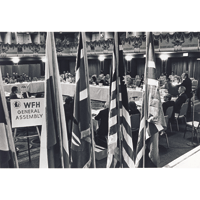The most recent World Federation of Hemophilia’s (WFH) World Congress, held in Paris in July 2012, brought together nearly 5,400 people from 130 countries. Clinicians, researchers, patients and national patient organization leaders spent five days learning about the latest treatments and global challenges in managing bleeding disorders. The WFH holds its World Congress every two years, but the meeting hasn’t been held in the United States in more than 20 years—until now. During the 2012 WFH General Assembly, the WFH national member organizations voted for the US to host the WFH 2016 World Congress in Miami.
A Dark Time
Val D. Bias, CEO of the National Hemophilia Foundation (NHF), remembers when the US closed its doors to members of the global bleeding disorders community. It couldn’t have come at a worse time.
Around 1966, clotting factor became a household miracle drug to help people in the US with bleeding disorders prevent bleeds. In less than a decade, about 70% of people with bleeding disorders relied on it. Then, by the early 1980s, it was confirmed that the factor supply, pooled from the blood of hundreds of donors, was contaminated with a new, aggressive virus—HIV, which causes AIDS. About half of the people with hemophilia contracted HIV/AIDS, whose symptoms included rare cancers and pneumonia.
After medical research discovered that HIV could spread from person to person, former President Ronald Reagan successfully pressured the US Public Health Service to add HIV and AIDS to an official list of “dangerous and contagious diseases” in 1987. This perpetuated a stigma against people with HIV/AIDS and upheld the perception that HIV could be spread through casual contact. It later led to a travel ban, hindering international visitors with HIV/AIDS from easily entering the US.
About the same time, homosexual men were identified as being at higher risk for contracting HIV. “The travel ban was more so a societal reaction to the gay community than to the bleeding disorders community,” explains Bias, who has severe hemophilia B. “But we were caught in the wave. It was already a dark time for our community.”
No Return
The WFH’s last World Congress in the US was in 1990 in Washington, DC. Because of the travel ban, airport officials could stop and question passengers with HIV medications in their luggage. Sometimes those passengers were prohibited from entering the country. The possibility of future harassment precluded the World Congress from returning to the United States.
The World Congress continued in cities all over the world, from Athens and Mexico City to Seville, Bangkok, Vancouver and Istanbul. The 2010 World Congress was held in Buenos Aires. Then, it met in Paris in 2012. The 2014 World Congress will be held in Melbourne, Australia. During the last 14 years, attendance has tripled.
The meeting draws international bleeding disorders experts, who share the latest research and treatment findings. Program tracks include laboratory sciences, nursing and dental care. Youth sessions are also offered, providing opportunities for the next generation to get educated and involved in issues affecting their peers in developed and developing countries.

Visions of America/Glow Images
The General Assembly of the
World Federation of Hemophilia,
New York Congress, 1977.
Aspiring host countries put in a bid seven years in advance to host the World Congress in one of their major cities. The WFH evaluates cities based on the national organizations’ financial viability to host the conference and the proposed cities’ accessibility. “That means not just getting into the city, but also getting around, getting to the convention location and addressing mobility issues,” explains Craig McEwen, former congress and meetings director for the WFH (2004–2012).
With the travel ban in place, many attendees and delegates could have been prevented from entering the US. This excluded NHF from meeting the criteria to bid. To help lift the travel ban, NHF turned its attention to advocacy.
People with bleeding disorders in the US have much greater access to the most advanced treatments. In contrast, as many as 75% of people with bleeding disorders around the world, especially in developing countries, have no access to medications and adequate clinical care.
“The world, which was grappling with AIDS and bleeding disorders, was not allowed to come here,” Bias says. “At NHF, we were continually sending letters of support to coalition members about the importance of lifting the ban—to the White House, to the Department of State.”
During the past two decades and five terms of three US presidents after Reagan—both Republican and Democrat—the travel ban remained in place.
Bias understands the long-term nature of advocacy efforts, having been a lobbyist on Capitol Hill from 1994 to 1998 before becoming Board President of the Hemophilia Foundation of Northern California. “I’ve been in advocacy most of my adult life,” he says. “It’s all about patience. If you lose patience, you lose focus. And you’ll never win.”
“This Was Our Chance”
In 2008, then-Illinois Senator Barack Obama ran a presidential campaign whose theme was based on one word—“change.” Changes in healthcare, including HIV/AIDS, were near the top of his agenda.
In October 2009, less than one year after being sworn in, President Obama announced that the travel ban would be lifted. The new federal rule was published in early 2010. At a press conference, the president underscored what lifting the ban symbolized: “We talk about reducing the stigma of this disease, yet we’ve treated a visitor living with it as a threat. If we want to be the global leader in combating HIV/AIDS, we need to act like it.”
Once the travel ban was lifted, NHF immediately launched the bidding process to host a WFH World Congress. Preparing a bid for the World Congress is much like bidding for the Olympics, with the country making a case for itself and the host city. WFH sends guidelines to bidding countries, which work with the prospective host city’s tourism bureau and convention center to meet several criteria. In addition to financial viability and accessibility, the criteria require easy access to visas and a strong capacity of the national organization and the country’s local clinical leadership to host programs. The host country’s social and political stability are also assessed.
Six to eight candidate countries typically apply to host the congress, which WFH narrows to four. The next step involves a site visit from WFH’s events team. The team scrutinizes the city to make sure the airport allows easy entry and departure. Hotel accommodations, local transportation and food must be affordable. The main location, usually a convention center, has to be able to host thousands of people, and hundreds of workshops and sessions.
After the site visits, the WFH Executive Committee selects two final candidates. The finalists then make pitch-style presentations to delegates from national member organizations at the WFH General Assembly following the World Congress. The delegates then vote.
And the Winner Is…
NHF lost its attempt to host the WFH 2014 World Congress. After that, it sprang into action, preparing its strategy to win the bid for the 2016 World Congress. To beat the other contender, Montreal, the US had to address the lingering feeling of discrimination from the travel ban in its pitch at the 2010 World Congress in Buenos Aires. “We had to make that a talking point—that the ban had been lifted and people with HIV were welcome in the United States,” Bias says.
NHF promoted its clinical expertise in creating quality education, such as the members of its Medical and Scientific Advisory Council (MASAC); its working groups for nurses, social workers and physical therapists; and its network of 135 hemophilia treatment centers across the US.
NHF also had to make a compelling argument that Miami, the host city, could show visitors a good time. NHF launched a beach-themed campaign just before the 2012 World Congress in Paris, and promoted Miami as an epicenter of cultural and economic diversity with easy access. “Miami is a huge international hub for air travel,” says Neil Frick, MS, NHF’s vice president for research and medical information. The city’s new international airport terminal would make entry and departure a breeze—the opposite of how it had been since 1987. Miami also has hotels, restaurants and museums surrounding the convention center and many cultural events nearby. Further, it is attractive to delegates from Latin America, many of whom had expressed financial and logistical concerns about traveling to more distant locales in Europe and Asia.
Before the 2012 World Congress, WFH hosted a global training session for national member organizations. NHF used its booth to entice delegates, showcasing the benefits of Miami as an event location and the United States as a leader in hemophilia research and treatment.
On the last day of the World Congress, the WFH General Assembly gathered. Bias made the final pitch, along with Craig Kessler, MD, MASAC chair; representatives from the Greater Miami Convention and Visitors Bureau; and the mayor of Miami Beach. Decades of waiting and years of bidding came down to 20 minutes for the General Assembly to cast votes.
Then, an LCD projector flashed the results—Miami had won.
“We jumped to our feet and screamed,” Frick says. “Everyone was excited. NHF will be front and center at the next congress in Melbourne, promoting the World Congress in Miami.”
The 2016 World Congress will likely be hosted in conjunction with NHF’s Annual Meeting. Attendance is expected to break records, drawing more than 7,000 people.
The WFH regards the win as more than a long-awaited visit to the US. “The whole bleeding disorders community is close-knit, everywhere you go in the world,” says John Bournas, WFH’s CEO and executive director. “We need to share information and ideas with each other. We are not one without the other.”

